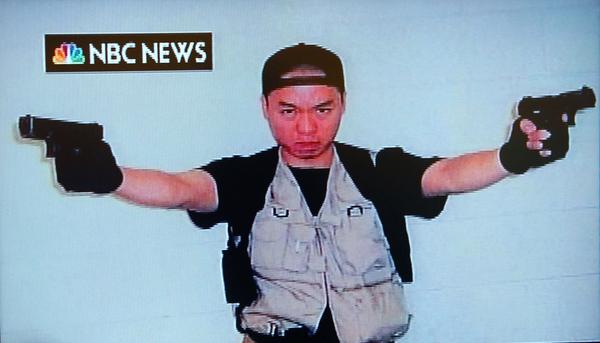 Another Stereotype of the Month entry:
Another Stereotype of the Month entry:
 Another Stereotype of the Month entry:
Another Stereotype of the Month entry:
A Native Perspective on Virginia Tech Headlines
Thursday, April 19, 2007
By Kat Teraji (kattoy@verizon.net)
Bury my heart at Wounded Knee, Deep in the Earth, Cover me with pretty lies — bury my heart at Wounded Knee. Didn't we learn to crawl, and still our history gets written in a liar's scrawl. They tell 'ya "Honey, you can still be an Indian d-d-down at the 'Y' on Saturday nights." — lyrics to "Bury My Heart at Wounded Knee," written by Buffy St. Marie
"The worst shooting rampage in American history…" "Massacre and Mourning, 33 die in worst shooting in U.S. History," and "Rampage called worst mass shooting in U.S. history." "What first appeared to be a single shooting death unfolded into the worst gun massacre in the nation's history." You've seen and heard these headlines and reports all week as the media provided non-stop coverage of the tragic shooting of 33 people at Virginia Tech University on Monday.
"The worst in U.S. history…" Really? It is certainly the worst shooting on a college campus in modern U.S. history. But if we think it is the worst shooting rampage in U.S. history, then we are a singularly uneducated nation.
"I can't take one more of these headlines," said Joan Redfern, a member of the Lakota Sioux tribe who lives in Hollister. We met at First Street Coffee to talk while we scanned Internet stories. "Haven't any of these people ever heard of the Massacre at Sand Creek in Colorado, where Methodist minister Col. Chivington massacred between 200 and 400 Cheyenne and Arapaho Indians, most of them women, children, and elderly men?"
Chivington specifically ordered the killing of children, and when he was asked why, he said, "Kill and scalp all, big and little; nits make lice."
At Wounded Knee Creek in South Dakota, the U.S. 7th Cavalry attacked 350 unarmed Lakota Sioux on December 29, 1890. While engaged in a spiritual practice known as the "Ghost Dance," approximately 90 warriors and 200 women and children were killed. Although the attack was officially reported as an "unjustifiable massacre" by Field Commander General Nelson A. Miles, 23 soldiers were awarded the Medal of Honor for the slaughter. The unarmed Lakota men fought back with bare hands. The elderly men and women stood and sang their death songs while falling under the hail of bullets. Soldiers stripped the bodies of the dead Lakota, keeping their ceremonial religious clothing as souvenirs.
"To say the Virginia shooting is the worst in all of U.S. history is to pour salt on old wounds-it means erasing and forgetting all of our ancestors who were killed in the past," Redfern said.
"The use of hyperbole and lack of historical perspective seems all too ubiquitous in much of the current mainstream media," Redfern said. "My intention is not to downplay the horror of what has happened this week in any way. But we have a 500-year history of mass shootings on American soil, and let's not forget it."
This is only the most recent mass shooting massacre in a long history of mass shootings in a country engaged in a long love affair with firearms and very little interest in gun control.
Let's not forget our history and the richness of our Native roots. While spending time on the 1.5 million acre Hopi Reservation in Arizona, I met families living in homes they have occupied for over 900 years. On the surface, it looks like a third world country: you will observe many homes without running water, travel unpaved roads, and notice that there are no building codes. But sitting in a Hopi home being served a delicious lunch cooked by a proud Hopi working mother, I experienced so much more: the continuity of a long and deep heritage, a sense of the sacred, an artistic expertise, and wisdom about many things that remain a mystery to my culture.
Most of all, may we never forget all those innocent civilian men, women, and children who lost their lives simply for being in the wrong place at the wrong time, just as the students happened to be this week in Virginia. May we always remember the precious humanity of these students, but may we also never forget the humanity of those who lost their lives simply for being born people Native to this country. ..
Kat Teraji is communications coordinator for a large non-profit organization that benefits women and children. Her column appears every Thursday in the Take 2 section of the Dispatch. You can reach her at kattoy@verizon.net.
Rob's comment
I think some people criticized Teraji's column for exaggerating what the media claimed about the Virginia Tech shootings. But here are some quotes on the subject.
From the NY Times, 4/17/07:
It was the deadliest shooting rampage in American history and came nearly eight years to the day after 13 people died at Columbine High School in Colorado at the hands of two disaffected students who then killed themselves.
From FoxNews.com, 4/16/07:
The man responsible for murdering 32 people — the worst mass-murder shooting in American history — who carried no ID, remained unidentified late Monday, police said.
Obviously, more people were massacred at the World Trade Center, Pearl Harbor, and Oklahoma City. But they were bombed, not shot. For shooting deaths occurring at one time and place, the Wounded Knee and Sand Creek massacres are probably the top two.
|
. . . |

|
All material © copyright its original owners, except where noted.
Original text and pictures © copyright 2007 by Robert Schmidt.
Copyrighted material is posted under the Fair Use provision of the Copyright Act,
which allows copying for nonprofit educational uses including criticism and commentary.
Comments sent to the publisher become the property of Blue Corn Comics
and may be used in other postings without permission.